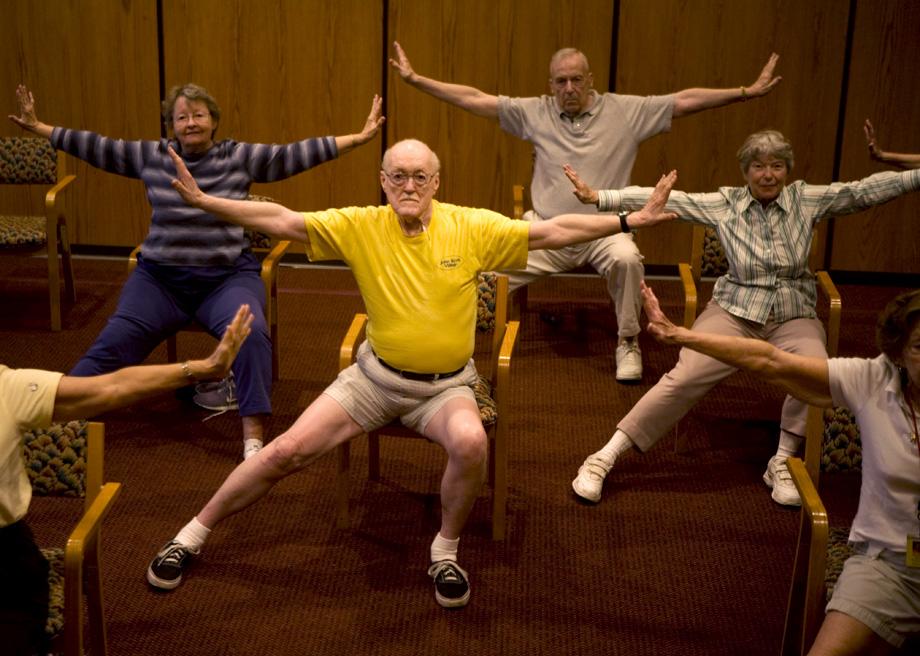
What can we do to make our average life expectancy jump again? Above,
residents of a continuing care retirement community practice chair
yoga.
Photo by Melanie Stetson Freeman/Christian Science Monitor/Getty Images
Read the rest of Laura Helmuth's series on longevity.
There’s an
oddly persistent myth
that people have always had a good chance of living to a ripe old age
if they could just survive childhood. Socrates was old, after all, and
what about Ben Franklin? It’s true that infants and children were once
more likely to die than people of any other ages. Eliminating many of
the deadly diseases of childhood gave the biggest boost to our average
life expectancy as it
doubled in the past 150 years. But children aren’t the only ones who are less likely to die than they were in the past.
At every age, even older than 100, people are
more likely to survive the next year than they were at any other time in human history.
Why has life expectancy continued to go up steadily over the past
several decades? And what’s in store for us: Will we continue to live
for more and more years than ever before?
Public health measures get the credit for most of the increase in
life expectancy that happened from the mid-1800s to mid-1900s. Clean
water, safe food, comfortable housing, and a healthy respect for germs
made the world
a completely different place.
If you look at the
top causes of death
in the United States in 1900 and 2010, you might think you’re examining
data from two entirely different species. In 1900, we died of
tuberculosis, gastrointestinal infections, and diphtheria. In 2010, none
of those diseases made it into the top 10. Take a tour of this
interactive to see how death rates changed over the course of the past
century. (The spike in 1918-1919 was caused by the Spanish flu, the
worst pandemic in history.) While infectious diseases plummeted over the course of the 20
th century, cancer and heart disease shot up.
Heart disease isn’t a new invention.
Egyptian mummies
show evidence of atherosclerosis. But it and cancer were masked by
other diseases that killed people before they got old enough to die of a
stroke.
Because
heart disease is such a killer, anything
that reduces its incidence or treats it can save a lot of lives and
boost our overall average life expectancy. The death rate from heart
disease (adjusting for age, since there are more and more older people
in the population) was cut in half between 1980 and 2000. That’s a
screaming success for
public health and biomedicine.
Who gets the credit? About half of the credit goes to medical
treatments (statins, aspirin, heart surgery), and the other half goes to
reductions in risk factors such as high blood pressure, smoking, and
eating red meat. More good news is that some risk factors, including high cholesterol, are
continuing to drop.
Heart disease is still a horribly common way to die, and it’s hard to
appreciate the number of deaths that didn’t happen. But you probably
have loved ones who are alive today because careful epidemiological
studies identified
risk factors for heart disease and medical researchers found effective treatments.
My great-great-grandmother died at age 57, probably of a heart
attack. My great-grandmother died at age 67 of a stroke. My grandmother
takes medication for high blood pressure and high cholesterol. She will
celebrate her 90th birthday next week. She is the first
person in her family to live long enough to see a great-grandchild.
Preventing and treating heart disease is a huge unsung victory of modern
times.
Deaths from many kinds of
cancer also decreased during the past few decades. Cancer isn’t a single disease, and it won’t be eliminated anytime soon,
foolish talk
from George W. Bush’s head of the National Cancer Institute aside. But
researchers and clinicians are making steady progress at identifying and
treating most forms of the disease.
Long-term survival rates are up. In 1975, about half of all cancer patients lived for five more years. Now the rate is two-thirds.
Even more important than treatment, though, is prevention. The
reduction in smoking
rates gets credit for much of the decrease in incidence of heart
disease and cancer, especially lung cancer, which is by far the
most common cause of cancer deaths.
Smoking bans are lifesavers, too—fewer people are
dying of heart attacks, stroke, or lung disease due to secondhand smoke now that it’s not stinking up all our restaurants, offices, and airplanes.
Controlling air pollution has been a big lifesaver in the United States. In 1948, a noxious smog choked
Donora, Pa.,
killing 20 people and sickening half of the population of 14,000. In
1952, a great smog in London killed at least 4,000 people. Air pollution
provokes heart attacks and asthma attacks and increases the risk of
lung cancer, heart disease, bronchitis, and other diseases. The Clean
Air Act was
passed in 1970
and has been revised several times with stricter limits on pollutants.
The law has led to great improvements in public health: It
prevented 160,000 premature deaths in 2010. You can even
see the mountains outside Los Angeles now, which you couldn’t do in 1968. Air pollution is still a big killer in the developing world, however, and is
blamed for more deaths worldwide than high cholesterol.
We have a completely different relationship to
safety today than we did at the beginning of the 20
th century. Workplace deaths are
down by 90 percent, thanks to efforts by
labor unions, researchers, and overreaching government agencies. We’re driving more miles than in the past but are much
less likely to die in traffic accidents.
People complain about U.S. culture being excessively litigious, but
there’s nothing like the threat of a lawsuit to make companies
recall dangerous products. Even death by lightning strikes is down;
God is smiting 70 percent fewer people than he did in 1960.
Fewer women die in
childbirth—although it took a shamefully long time for the
maternal mortality rate to decrease.
Safe and effective birth control has saved women from dying in unwanted
pregnancies. Improved delivery practices cut death rates from
infection, hemorrhage, and other complications. And
continuing improvements to neonatal care mean that more infants and mothers survive the dangers of childbirth.
Antibiotics are the lifesavers that are most familiar to us. When I asked my acquaintances
why they weren’t dead yet,
the most common stories involved infections that had been cured by
antibiotics. Today we’re publishing some of the best #NotDeadYet stories
that people
tweeted or emailed to us over the past week. Many of you alive today would have been vanquished by bacteria in previous eras.
The
public health interventions that protect children from infectious disease continue to echo throughout their lifespan. People who reach old age today are
stronger and healthier than earlier generations, partly because they weren’t
weakened in childhood by
repeated infections.
As more people live to old age, they have more time to develop diseases
of aging, the most devastating of which is dementia. But taking age
into account, the rate of dementia
seems to be falling, probably because of improved overall health.
Life expectancy can make sudden jumps even in older populations in response to
social conditions.
Before the reunification of Germany, retirees living in the former East
Germany had much lower life expectancies than their cousins in the
West. After reunification, they started living much longer—even
people in their 80s and 90s had years added to their lives.
People with more years of
education live longer, and the
gap is widening
between people who didn’t graduate high school and those who have
college degrees. That may not be surprising since the well-educated are
also wealthier on average and have safer jobs and better access to
health care. But a few studies have found that
education in itself
prolongs life; it seems to allow people to manage chronic diseases
better, handle stress, and make better judgments. The proportion of the
population with some college education has been growing, and that may
pay off in better long-term health outcomes.
It’s all connected, of course—the reason we live longer today is that we are
living in an entirely different world than the one people inhabited at the end of the 19
th century. It’s less nasty,
less brutish,
and less short. One final reason we’re living longer is that we have
less exposure to the most heart-breaking risk factor for death:
bereavement. In other words, we are living longer because
our loved ones are living longer, and thus we are less likely to be sunk in grief than at any time in human history.
So what’s next? What are the little things that could make our
average life expectancy jump again? Some of them sound simple but really
aren’t. “The biggest low-hanging fruit is smoking,” says medical
historian David Jones of Harvard. “But is it really low-hanging?” About
half of the population smoked in the mid-20
th century. That rate
dropped steadily until the latter part of the century, but it seems to have plateaued (although a recent
gruesome ad campaign
had promising results). About 20 percent of the population smokes, and
it may be very difficult to get the remaining holdouts to quit.
Obesity is the other major risk factor for heart disease, cancer,
diabetes, and any number of other causes of death. The obesity rate
climbed so much in the past few decades that S. Jay Olshansky, a
longevity researcher at the University of Illinois–Chicago, and his
colleagues estimate that
obesity could swamp the effects of reduced smoking on average life expectancy.
The most disturbing fact about life expectancy in the United States
today is that African-Americans live about four years fewer on average
than whites. The good news is that
the gap has been narrowing.
This disparity has been seen as a matter of social justice, but as
Jones points out, there’s also a major gap in life expectancy between
males and females. “I can expect to live five years less than my wife,”
he says. “To me, this feels totally unfair.” We tend to think of this
difference as something biological and immutable, but finding ways to
help men live as long as women would go a long way toward improving life
expectancy and making the world a less sorrowful place.
The United States could learn a lot from other developed countries.
Our life expectancy is much shorter than it should be considering how
wealthy we are. By some estimates, we’re
40 years behind other countries in terms of advancing life expectancy. The National Academy of Sciences took a
hard look at what we’re doing wrong
and identified nine things that set the United States apart from other
countries, including drug and alcohol use, HIV and AIDS, adolescent
pregnancy, and
injuries and homicide. The Centers for Disease Control and Prevention calls many of these problems “
winnable battles.”
One of the most fascinating debates in life science these days is between
Olshansky and
James Vaupel
of the Max Planck Institute for Demographic Research in Rostock,
Germany. They disagree fundamentally about whether and how average life
expectancy will increase in the future, and they’ve been arguing about
it for 20 years. Olshansky, a lovely guy, takes what at first sounds
like the pessimistic view. He says the public health measures that
raised life expectancy so dramatically from the late 1800s to today have
done about as much as they can. We now have a much older population,
dying of age-related diseases, and any improvements in treatment will
add only incrementally to average life expectancy, and with vanishing
returns. He explains his point of view in this charming animated video.
Video is courtesy of Project M.
On the other side of the ring is Vaupel, who says that people are
living longer and healthier lives all the time and there is
no necessary end in sight. His message is cheerier, but he takes the debate very seriously; he
won’t attend conferences
where Olshansky is present. His charts are heartening; he takes the
records of the longest-lived people in the longest-lived countries for
each year and shows that maximum lifespan has been
zooming up linearly from 1800 to today. One wants to mentally extend the line into all of our foreseeable futures.
Olshansky says the only way to make major improvements in life
expectancy is to find new ways to prevent and treat the diseases of
aging. And the most efficient way to do that is to
delay the process of aging itself.
That’s something that some people already do—somehow. Olshansky says,
“The study of the genetics of long-lived people, I think, is going to be
the breakthrough technology.” Scientists can now easily extend lifespan
in flies, worms, and mice, and there’s a lot of exciting research on
genetic pathways in humans that might slow down the aging process and
presumably protect us from the age-related diseases that kill most
people today. “The secret to longer lives is contained in our own
genomes,” Olshansky says.
Predictions about medical breakthroughs are notoriously optimistic,
of course. When the human genome was sequenced, people predicted
personalized medical interventions in a decade. That was 12 years ago.
Richard Nixon’s war on cancer has yet to be won. So while you’re
waiting, do what you can. Eat right, exercise. Drive safely. Don’t smoke
or play with fire. Get that mole looked at. Are you sitting in front of
a computer screen now?
Stand up and stretch, do some lunges, we won’t laugh. Here’s to your health and long life.
Read the rest of Laura Helmuth's series on longevity.














